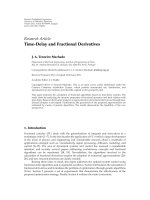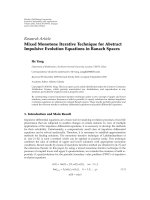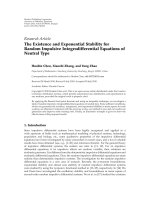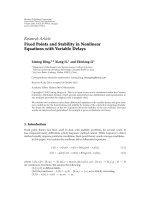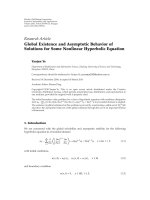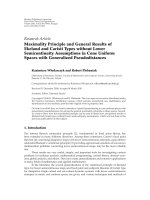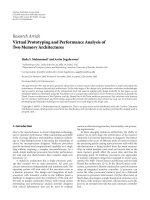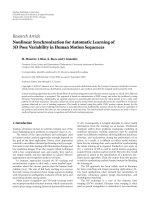Báo cáo hóa học: " Research Article Fixed Points and Hyers-Ulam-Rassias Stability of Cauchy-Jensen Functional Equations in Banach Algebras" docx
Bạn đang xem bản rút gọn của tài liệu. Xem và tải ngay bản đầy đủ của tài liệu tại đây (535.04 KB, 15 trang )
Hindawi Publishing Corporation
Fixed Point Theory and Applications
Volume 2007, Article ID 50175, 15 pages
doi:10.1155/2007/50175
Research Article
Fixed Points and Hyers-Ulam-Rassias Stability of Cauchy-Jensen
Functional Equations in Banach Algebras
Choonkil Park
Received 16 April 2007; Accepted 25 July 2007
Recommended by Billy E. Rhoades
We prove the Hyers-Ulam-Rassias stability of homomorphisms in real Banach algebras
and of generalized derivations on real Banach algebras for the following Cauchy-Jensen
functional e quations: f (x + y/2+z)+ f (x
− y/2+z) = f (x)+2f (z), 2 f (x + y/2+z) =
f (x)+ f (y)+2f (z), which were introduced and investigated by Baak (2006). The con-
cept of Hyers-Ulam-Rassias stability originated from Th. M. Rassias’ stability theorem
that appeared in his paper (1978).
Copyright © 2007 Choonkil Park. This is an open access article distributed under the
Creative Commons Attribution License, which permits unrestricted use, distribution,
and reproduction in any medium, provided the original work is properly cited.
1. Introduction and preliminaries
The stability problem of functional equations originated from a question of Ulam [2]
concerning the stability of group homomorphisms: let (G
1
,∗) be a group and let
(G
2
,,d) be a metric group with the metric d(·,·). Given > 0, does there exist a δ() > 0
such that if a mapping h : G
1
→ G
2
satisfies the inequality
d
h(x ∗ y),h(x) h(y)
<δ (1.1)
for all x, y
∈ G
1
, then there is a homomorphism H : G
1
→ G
2
with
d
h(x),H(x)
< (1.2)
for all x
∈ G
1
? If the answer is affirmative, we would say that the e quation of homo-
morphism H(x
∗ y) = H(x) H(y) is stable. The concept of stability for a functional
equation arises when we replace the functional equation by an inequality which acts as a
perturbation of the equation. Thus, the stability question of functional equations is that
2 Fixed Point Theory and Applications
“how do the solutions of the inequality di ffer from those of the given functional equa-
tion”?
Hyers [3]gaveafirstaffirmative answer to the question of Ulam for Banach spaces.
Let X and Y be Banach spaces. Assume that f : X
→ Y satisfies
f (x + y) − f (x) − f (y)
≤
ε (1.3)
for all x, y
∈ X and some ε ≥ 0. Then, there exists a unique additive mapping T : X → Y
such that
f (x) − T(x)
≤
ε (1.4)
for all x
∈ X.
Rassias [4] provided a generalization of Hyers’ theorem which allows the
Cauchy difference to be unbounded.
Theorem 1.1 (Th. M. Rassias). Let f : E
→ E
be a mapping from anormed vector space E
into a Banach space E
subject to the inequality
f (x + y) − f (x) − f (y)
≤
x
p
+ y
p
(1.5)
for all x, y
∈ E,where and p are constants with > 0 and p<1. Then, the limit
L(x)
= lim
n→∞
f
2
n
x
2
n
(1.6)
exists for all x
∈ E and L : E → E
is the unique addit ive mapping which satisfies
f (x) − L(x)
≤
2
2 − 2
p
x
p
(1.7)
for all x
∈ E. Also, if for each x ∈ E the function f (tx) is continuous in t ∈ R, then L is
R-linear.
The above inequality (1.5) has provided a lot of influence in the development of what is
now known as a Hyers-Ulam-Rassias stability of functional equations. Beginning around
the year 1980, the topic of approximate homomorphisms, or the stability of the equa-
tion of homomorphism, was studied by a number of mathematicians. G
˘
avrut¸a [5]gen-
eralized Rassias’ result. The stability problems of several functional equations have been
extensively investigated by a number of authors and there are many interesting results
concerning this problem (see [6–17]).
Rassias [18], following the spirit of the innovative approach of Rassias [4] for the u n-
bounded Cauchy difference, proved a similar stability theorem in which he replaced the
factor
x
p
+ y
p
by x
p
·y
q
for p,q ∈ R with p + q = 1 (see also [19]foranumber
of other new results).
Choonkil Park 3
Theorem 1.2 [18–20]. Let X be a real normed linear space and Y a real complete normed
linear space. Assume that f : X
→ Y is an approximately additive mapping for which there
exist constants θ
≥ 0 and p ∈ R −{1} such that f satisfies the inequality
f (x + y) − f (x) − f (y)
≤
θ ·x
p/2
·y
p/2
(1.8)
for all x, y
∈ X. Then, there exists a unique additive mapping L : X → Y satisfying
f (x) − L(x)
≤
θ
|2
p
− 2|
x
p
(1.9)
for all x
∈ X. If, in addition, f : X → Y is a mapping such that the transformation t → f (tx)
is continuous in t
∈ R for each fixed x ∈ X, then L is an R-linear mapping.
We recall two fundamental results in fixed point theory.
Theorem 1.3 [21]. Let (X,d) be a complete metric space and let J : X
→ X be strictly con-
tractive, that is,
d(Jx,Jy)
≤ Lf(x, y), ∀x, y ∈ X (1.10)
for some Lipschitz constant L<1.Then,
(1) the mapping J has a unique fixed point x
∗
= Jx
∗
;
(2) the fixed point x
∗
is globally attractive, that is,
lim
n→∞
J
n
x = x
∗
(1.11)
for any starting point x
∈ X;
(3) one has the following estimation inequalities:
d
J
n
x, x
∗
≤
L
n
d
x, x
∗
,
d
J
n
x, x
∗
≤
1
1 − L
d
J
n
x, J
n+1
x
,
d(x,x
∗
) ≤
1
1 − L
d(x,Jx)
(1.12)
for all nonnegative integers n and all x
∈ X.
Let X be a set. A function d : X
× X → [0,∞]iscalledageneralized metric on X if d
satisfies the following:
(1) d(x, y)
= 0ifandonlyifx = y;
(2) d(x, y)
= d(y,x)forallx, y ∈ X;
(3) d(x,z)
≤ d(x, y)+ f (y,z)forallx, y,z ∈ X.
Theorem 1.4 [22]. Let (X,d) be a complete generalized metric space and let J : X
→ X be
a strictly contractive mapping with Lipschitz constant L<1. Then, for each g iven element
x
∈ X, either
d
J
n
x, J
n+1
x
=∞
(1.13)
4 Fixed Point Theory and Applications
for all nonnegative integers n or there exists a positive integer n
0
such that
(1) d
J
n
x, J
n+1
x
< ∞, ∀n ≥ n
0
;
(2) the sequence
J
n
x
converges to a fixed point y
∗
of J;
(3) y
∗
is the unique fixed point of J in the set Y ={y ∈ X | d( J
n
0
x, y) < ∞};
(4) d
y, y
∗
≤
(1/(1 − L))d(y,Jy) for all y ∈ Y.
This paper is organized as follows. In Section 2, using the fixed point method, we
prove the Hyers-Ulam-Rassias stability of homomorphisms in real Banach algebras for
the Cauchy-Jensen functional equations.
In Section 3, using the fixed point method, we prove the Hyers-Ulam-Rassias stabil-
ity of generalized derivations on real Banach algebras for the Cauchy-Jensen functional
equations.
2. Stability of homomorphisms in real Banach algebras
Throughout this section, assume that A is a real Banach algebra with norm
·
A
and
that B is a real Banach algebra with norm
·
B
.
For a given mapping f : A
→ B,wedefine
Cf(x, y,z):
= f
x + y
2
+ z
+ f
x − y
2
+ z
−
f (x) − 2 f (z) (2.1)
for all x, y,z
∈ A.
We prove the Hyers-Ulam-Rassias stability of homomorphisms in real Banach algebras
for the functional equation Cf(x, y,z)
= 0.
Theorem 2.1. Le t f : A
→ B be a mapping for which there exists a function ϕ : A
3
→ [0,∞)
such that
∞
j=0
1
2
j
ϕ
2
j
x,2
j
y,2
j
z
< ∞, (2.2)
Cf(x, y,z)
B
≤ ϕ(x, y,z), (2.3)
f (xy) − f (x) f (y)
B
≤ ϕ(x, y, 0) (2.4)
for all x, y,z
∈ A.IfthereexistsanL<1 such that ϕ(x,x,x) ≤ 2Lϕ(x/2,x/2,x/2) for all
x
∈ A and if f (tx) is continuous in t ∈ R for each fixed x ∈ A, then there ex ists a unique
homomorphism H : A
→ B such that
f (x) − H(x)
B
≤
1
2 − 2L
ϕ(x, x,x) (2.5)
for all x
∈ A.
Proof. Consider the set
X :
={g : A → B} (2.6)
Choonkil Park 5
and introduce the generalized metric on X:
d(g,h)
= inf
C ∈ R
+
:
g(x) − h(x)
B
≤ Cϕ(x,x,x), ∀x ∈ A
. (2.7)
It is easy to show that (X,d)iscomplete.
Now, we consider the linear mapping J : X
→ X such that
Jg(x):
=
1
2
g(2x) (2.8)
for all x
∈ A.
By [21, Theorem 3.1],
d(Jg,Jh)
≤ Ld(g,h) (2.9)
for all g,h
∈ X.
Letting y
= z = x in (2.3), we get
f (2x) − 2 f (x)
B
≤ ϕ(x,x,x) (2.10)
for all x
∈ A.So
f (x) −
1
2
f (2x)
B
≤
1
2
ϕ(x, x,x) (2.11)
for all x
∈ A.Henced( f ,Jf) ≤ 1/2.
By Theorem 1.4, there exists a mapping H : A
→ B such that the following hold.
(1) H is a fixed point of J, that is,
H(2x)
= 2H(x) (2.12)
for all x
∈ A. The mapping H is a unique fixed point of J in the set
Y
=
g ∈ X : d( f ,g) < ∞
. (2.13)
This implies that H is a unique mapping satisfying (2.12) such that there exists
C
∈ (0,∞) satisfying
H(x) − f (x)
B
≤ Cϕ(x,x,x) (2.14)
for all x
∈ A.
(2) d(J
n
f ,H) → 0asn →∞. This implies the equality
lim
n→∞
f
2
n
x
2
n
= H(x) (2.15)
for all x
∈ A.
6 Fixed Point Theory and Applications
(3) d( f ,H)
≤ (1/(1 − L))d( f ,Jf), which implies the inequalit y
d( f ,H)
≤
1
2 − 2L
. (2.16)
This implies that the inequality (2.5)holds.
It follows from (2.2), (2.3), and (2.15)that
H
x + y
2
+ z
+ H
x − y
2
+ z
−
H(x) − 2H(z)
B
= lim
n→∞
1
2
n
f
2
n−1
(x + y)+2
n
z
+ f
2
n−1
(x − y)+2
n
z
−
f (2
n
x) − 2 f
2
n
z
B
≤ lim
n→∞
1
2
n
ϕ
2
n
x,2
n
y,2
n
z
=
0
(2.17)
for all x, y,z
∈ A.So
H
x + y
2
+ z
+ H
x − y
2
+ z
=
H(x)+2H(z) (2.18)
for all x, y,z
∈ A.By[1, Lemma 2.1], the mapping H : A → B is Cauchy additive.
By the same reasoning as in the proof of Theorem of [4], the mapping H : A
→ B is
R-linear.
It follows from (2.4)that
H(xy) − H(x)H(y)
B
= lim
n→∞
1
4
n
f
4
n
xy
−
f
2
n
x
f
2
n
y
B
≤ lim
n→∞
1
4
n
ϕ
2
n
x,2
n
y,0
≤
lim
n→∞
1
2
n
ϕ
2
n
x,2
n
y,0
=
0
(2.19)
for all x, y
∈ A.So
H(xy)
= H(x)H(y) (2.20)
for all x, y
∈ A.Thus,H : A → B is a homomorphism satisfying (2.5), as desired.
Corollar y 2.2. Let r<1 and θ be nonnegative real numbers, and let f : A → B be a map-
ping such that
Cf(x, y,z)
B
≤ θ
x
r
A
+ y
r
A
+ z
r
A
,
f (xy) − f (x) f (y)
B
≤ θ
x
r
A
+ y
r
A
(2.21)
for all x, y,z
∈ A.If f (tx) is continuous in t ∈ R for each fixed x ∈ A, then there exists a
unique homomorphism H : A
→ B such that
f (x) − H(x)
B
≤
3θ
2 − 2
r
x
r
A
(2.22)
for all x
∈ A.
Choonkil Park 7
Proof. The proof follows from Theorem 2.1 by taking
ϕ(x, y,z):
= θ
x
r
A
+ y
r
A
+ z
r
A
(2.23)
for all x, y,z
∈ A.Then,L = 2
r−1
and we get the desired result.
Theorem 2.3. Le t f : A → B be a mapping for which there exists a function ϕ : A
3
→ [0,∞)
satisfying (2.3)and(2.4) such that
∞
j=0
4
j
ϕ
x
2
j
,
y
2
j
,
z
2
j
< ∞ (2.24)
for all x, y,z
∈ A.IfthereexistsanL<1 such that ϕ(x,x,x) ≤ (1/2)Lϕ(2x,2x,2x) for all
x
∈ A and if f (tx) is continuous in t ∈ R for each fixed x ∈ A, then there ex ists a unique
homomorphism H : A
→ B such that
f (x) − H(x)
B
≤
L
2 − 2L
ϕ(x, x,x) (2.25)
for all x
∈ A.
Proof. We consider the linear mapping J : X
→ X such that
Jg(x):
= 2g
x
2
(2.26)
for all x
∈ A.
It follows from (2.10)that
f (x) − 2 f
x
2
B
≤ ϕ
x
2
,
x
2
,
x
2
≤
L
2
ϕ(x, x,x) (2.27)
for all x
∈ A.Henced( f ,Jf) ≤ L/2.
By Theorem 1.4, there exists a mapping H : A
→ B such that the following hold.
(1) H is a fixed point of J, that is,
H(2x)
= 2H(x) (2.28)
for all x
∈ A. The mapping H is a unique fixed point of J in the set
Y
=
g ∈ X : d( f ,g) < ∞
. (2.29)
This implies that H is a unique mapping satisfying (2.28) such that there exists
C
∈ (0,∞) satisfying
H(x) − f (x)
B
≤ Cϕ(x,x,x) (2.30)
for all x
∈ A.
8 Fixed Point Theory and Applications
(2) d(J
n
f ,H) → 0asn →∞. This implies the equality
lim
n→∞
2
n
f
x
2
n
=
H(x) (2.31)
for all x
∈ A.
(3) d( f ,H)
≤ (1/(1 − L))d( f ,Jf), which implies the inequalit y
d( f ,H)
≤
L
2 − 2L
, (2.32)
which implies that the inequality (2.25)holds.
It follows from (2.3), (2.24), and (2.31)that
H
x + y
2
+ z
+ H
x − y
2
+ z
−
H(x) − 2H(z)
B
= lim
n→∞
2
n
f
x + y
2
n+1
+
z
2
n
+ f
x − y
2
n+1
+
z
2
n
−
f
x
2
n
−
2 f
z
2
n
B
≤ lim
n→∞
2
n
ϕ
x
2
n
,
y
2
n
,
z
2
n
≤
lim
n→∞
4
n
ϕ
x
2
n
,
y
2
n
,
z
2
n
=
0
(2.33)
for all x, y,z
∈ A.So
H
x + y
2
+ z
+ H
x − y
2
+ z
=
H(x)+2H(z) (2.34)
for all x, y,z
∈ A.By[1, Lemma 2.1], the mapping H : A → B is Cauchy additive.
By the same reasoning as in the proof of Theorem of [4], the mapping H : A
→ B is
R-linear.
It follows from (2.4)that
H(xy) − H(x)H(y)
B
= lim
n→∞
4
n
f
xy
4
n
−
f
x
2
n
f
y
2
n
B
≤ lim
n→∞
4
n
ϕ
x
2
n
,
y
2
n
,0
=
0
(2.35)
for all x, y
∈ A.So
H(xy)
= H(x)H(y) (2.36)
for all x, y
∈ A.Thus,H : A → B is a homomorphism satisfying (2.25), as desired.
Corollar y 2.4. Let r>2 and θ be nonnegative real numbers, and let f : A → B be a map-
ping satisfying (2.21). If f (tx) is continuous in t
∈ R for each fixed x ∈ A, then there exists
a unique homomorphism H : A
→ B such that
f (x) − H(x)
B
≤
3θ
2
r
− 2
x
r
A
(2.37)
for all x
∈ A.
Choonkil Park 9
Proof. The proof follows from Theorem 2.3 by taking
ϕ(x, y,z):
= θ
x
r
A
+ y
r
A
+ z
r
A
(2.38)
for all x, y,z
∈ A.Then,L = 2
1−r
and we get the desired result.
3. Stability of generalized derivations on real Banach algebras
Throughout this section, assume that A is a real Banach algebra with norm
·
A
.
For a given mapping f : A
→ A,wedefine
Df(x, y,z):
= 2 f
x + y
2
+ z
−
f (x) − f (y) − 2 f (z) (3.1)
for all x, y,z
∈ A.
Definit ion 3.1 [23]. A generalized derivation δ : A
→ A is R-linear and fulfills the general-
ized Leibniz rule
δ(xyz)
= δ(xy)z − xδ(y)z + xδ(yz) (3.2)
for all x, y,z
∈ A.
We prove the Hyers-Ulam-Rassias stability of generalized derivations on real Banach
algebras for the functional equation Df(x, y,z)
= 0.
Theorem 3.2. Let f : A
→ A be a mapping for which there exists a function ϕ : A
3
→ [0,∞)
satisfying (2.2) such that
Df(x, y,z)
A
≤ ϕ(x, y, z), (3.3)
f (xyz) − f (xy)z + xf(y)z − xf(yz)
A
≤ ϕ(x, y, z) (3.4)
for all x, y,z
∈ A.IfthereexistsanL<1 such that ϕ(x,x,x) ≤ 2Lϕ(x/2,x/2,x/2) for all
x
∈ A and if f (tx) is continuous in t ∈ R for each fixed x ∈ A, then there ex ists a unique
generalized derivation δ : A
→ A such that
f (x) − δ(x)
A
≤
1
4 − 4L
ϕ(x, x,x) (3.5)
for all x
∈ A.
Proof. Consider the set
X :
={g : A → A} (3.6)
and introduce the generalized metric on X:
d(g,h)
= inf
C ∈ R
+
:
g(x) − h(x)
A
≤ Cϕ(x,x,x), ∀x ∈ A
. (3.7)
It is easy to show that (X,d)iscomplete.
10 Fixed Point Theory and Applications
We consider the linear mapping J : X
→ X such that
Jg(x):
=
1
2
g(2x) (3.8)
for all x
∈ A.
By [21, Theorem 3.1],
d(Jg,Jh)
≤ Ld(g,h) (3.9)
for all g,h
∈ X.
Letting y
= z = x in (3.3), we get
2 f (2x) − 4 f (x)
A
≤ ϕ(x,x,x) (3.10)
for all x
∈ A.So
f (x) −
1
2
f (2x)
A
≤
1
4
ϕ(x, x,x) (3.11)
for all x
∈ A.Henced( f ,Jf) ≤ 1/4.
By Theorem 1.4, there exists a mapping δ : A
→ A such that the following hold.
(1) δ is a fixed point of J, that is,
δ(2x)
= 2δ(x) (3.12)
for all x
∈ A. The mapping δ is a unique fixed point of J in the set
Y
=
g ∈ X : d( f ,g) < ∞
. (3.13)
This implies that δ is a unique mapping satisfying (3.12) such that there exists
C
∈ (0,∞) satisfying
δ(x) − f (x)
A
≤ Cϕ(x,x,x) (3.14)
for all x
∈ A.
(2) d(J
n
f ,δ) → 0asn →∞. This implies the equality
lim
n→∞
f
2
n
x
2
n
= δ(x) (3.15)
for all x
∈ A.
(3) d( f ,δ)
≤ (1/(1 − L))d( f ,Jf), which implies the inequalit y
d( f ,δ)
≤
1
4 − 4L
. (3.16)
This implies that the inequality (3.5)holds.
Choonkil Park 11
It follows from (2.2), (3.3), and (3.15)that
2δ
x + y
2
+ z
−
δ(x) − δ(y) − 2δ(z)
A
= lim
n→∞
1
2
n
2 f
2
n−1
(x + y)+2
n
z
−
f
2
n
x
−
f
2
n
y
−
2 f
2
n
z
A
≤ lim
n→∞
1
2
n
ϕ
2
n
x,2
n
y,2
n
z
=
0
(3.17)
for all x, y,z
∈ A.So
2δ
x + y
2
+ z
=
δ(x)+δ(y)+2δ(z) (3.18)
for all x, y,z
∈ A.By[1, Lemma 2.1 ], the mapping δ : A → A is Cauchy additive.
By the same reasoning as in the proof of Theorem of [4], the mapping δ : A
→ A is
R-linear.
It follows from (3.4)that
δ(xyz) − δ(xy)z + xδ(y)z − xδ(yz)
A
= lim
n→∞
1
8
n
f
8
n
xyz
−
f
4
n
xy
·
2
n
z +2
n
xf
2
n
y
·
2
n
z − 2
n
xf
4
n
yz
A
≤ lim
n→∞
1
8
n
ϕ
2
n
x,2
n
y,2
n
z
≤
lim
n→∞
1
2
n
ϕ
2
n
x,2
n
y,2
n
z
=
0
(3.19)
for all x, y,z
∈ A.So
δ(xyz)
= δ(xy)z − xδ(y)z + xδ(yz) (3.20)
for all x, y,z
∈ A.Thus,δ : A → A is a generalized derivation satisfying (3.5).
Corollar y 3.3. Let r<1 and θ be nonnegative real numbers, and let f : A → A be a map-
ping such that
Df(x, y,z)
A
≤ θ ·x
r/3
A
·y
r/3
A
·z
r/3
A
,
f (xyz) − f (xy)z + xf(y)z − xf(yz)
A
≤ θ ·x
r/3
A
·y
r/3
A
·z
r/3
A
(3.21)
for all x, y,z
∈ A.If f (tx) is continuous in t ∈ R for each fixed x ∈ A, then there exists a
unique generalized der ivat ion δ : A
→ A such that
f (x) − δ(x)
A
≤
θ
4 − 2
r+1
x
r
A
(3.22)
for all x
∈ A.
Proof. The proof follows from Theorem 3.2 by taking
ϕ(x, y,z):
= θ ·x
r/3
A
·y
r/3
A
·z
r/3
A
(3.23)
for all x, y,z
∈ A.Then,L = 2
r−1
and we get the desired result.
12 Fixed Point Theory and Applications
Theorem 3.4. Let f : A
→ A be a mapping for which there exists a function ϕ : A
3
→ [0,∞)
satisfying (3.3)and(3.4) such that
∞
j=0
8
j
ϕ
x
2
j
,
y
2
j
,
z
2
j
< ∞ (3.24)
for all x, y,z
∈ A.IfthereexistsanL<1 such that ϕ(x,x,x) ≤ (1/2)Lϕ(2x,2x,2x) for all
x
∈ A and if f (tx) is continuous in t ∈ R for each fixed x ∈ A, then there ex ists a unique
generalized derivation δ : A
→ A such that
f (x) − δ(x)
A
≤
L
4 − 4L
ϕ(x, x,x) (3.25)
for all x
∈ A.
Proof. We consider the linear mapping J : X
→ X such that
Jg(x):
= 2g
x
2
(3.26)
for all x
∈ A.
It follows from (3.10)that
f (x) − 2 f
x
2
A
≤
1
2
ϕ
x
2
,
x
2
,
x
2
≤
L
4
ϕ(x, x,x) (3.27)
for all x
∈ A.Henced( f ,Jf) ≤ L/4.
By Theorem 1.4, there exists a mapping δ : A
→ A such that the following hold.
(1) δ is a fixed point of J, that is,
δ(2x)
= 2δ(x) (3.28)
for all x
∈ A. The mapping δ is a unique fixed point of J in the set
Y
=
g ∈ X : d( f ,g) < ∞
. (3.29)
This implies that δ is a unique mapping satisfying (3.28) such that there exists
C
∈ (0,∞) satisfying
δ(x) − f (x)
A
≤ Cϕ(x,x,x) (3.30)
for all x
∈ A.
(2) d
J
n
f ,δ
→
0asn →∞. This implies the equality
lim
n→∞
2
n
f
x
2
n
=
δ(x) (3.31)
for all x
∈ A.
Choonkil Park 13
(3) d( f ,δ)
≤ (1/(1 − L))d( f ,Jf), which implies the inequalit y
d( f ,δ)
≤
L
4 − 4L
, (3.32)
which implies that the inequality (3.25)holds.
It follows from (3.3), (3.24), and (3.31)that
2δ
x + y
2
+ z
−
δ(x) − δ(y) − 2δ(z)
A
= lim
n→∞
2
n
2 f
x + y
2
n+1
+
z
2
n
−
f
x
2
n
−
f
y
2
n
−
2 f
z
2
n
A
≤ lim
n→∞
2
n
ϕ
x
2
n
,
y
2
n
,
z
2
n
≤
lim
n→∞
8
n
ϕ
x
2
n
,
y
2
n
,
z
2
n
=
0
(3.33)
for all x, y,z
∈ A.So
2δ
x + y
2
+ z
=
δ(x)+δ(y)+2δ(z) (3.34)
for all x, y,z
∈ A.By[1, Lemma 2.1], the mapping δ : A → A is Cauchy additive.
By the same reasoning as in the proof of Theorem of [4], the mapping δ : A
→ A is
R-linear.
It follows from (3.4)that
δ(xyz) − δ(xy)z + xδ(y)z − xδ(yz)
A
= lim
n→∞
8
n
f
xyz
8
n
−
f
xy
4
n
·
z
2
n
+
x
2
n
f
y
2
n
·
z
2
n
−
x
2
n
f
yz
4
n
A
≤ lim
n→∞
8
n
ϕ
x
2
n
,
y
2
n
,
z
2
n
=
0
(3.35)
for all x, y,z
∈ A.So
δ(xyz)
= δ(xy)z − xδ(y)z + xδ(yz) (3.36)
for all x, y,z
∈ A.Thus,δ : A → A is a generalized derivation satisfying (3.28).
Corollar y 3.5. Let r>3 and θ be nonnegative real numbers, and let f : A → A be a map-
ping satisfying (3.21). If f (tx) is continuous in t
∈ R for each fixed x ∈ A, then there exists
auniquegeneralizedderivationδ : A
→ A such that
f (x) − δ(x)
A
≤
θ
2
r+1
− 4
x
r
A
(3.37)
for all x
∈ A.
Proof. The proof follows from Theorem 3.4 by taking
ϕ(x, y,z):
= θ ·x
r/3
A
·y
r/3
A
·z
r/3
A
(3.38)
for all x, y,z
∈ A.Then,L = 2
1−r
and we get the desired result.
14 Fixed Point Theory and Applications
References
[1] C. Baak, “Cauchy-Rassias stability of Cauchy-Jensen additive mappings in Banach spaces,” Acta
Mathematica Sinica, vol. 22, no. 6, pp. 1789–1796, 2006.
[2] S.M.Ulam,A Collection of Mathematical Problems, Interscience Tra cts in Pure and Applied
Mathematics, no. 8, Interscience, New York, NY, USA, 1960.
[3] D. H. Hyers, “On the stability of the linear functional equation,” Proceedings of the National
Academy of Sciences of the United States of America, vol. 27, no. 4, pp. 222–224, 1941.
[4] Th. M. Rassias, “On the stability of the linear mapping in Banach spaces,” Proceedings of the
American Mathematical Soc iety, vol. 72, no. 2, pp. 297–300, 1978.
[5] P. G
˘
avrut¸a, “A generalization of the Hyers-Ulam-Rassias stability of approximately additive
mappings,” Journal of Mathematical Analysis and Applications, vol. 184, no. 3, pp. 431–436,
1994.
[6] C G. Park, “On the stability of the linear mapping in Banach modules,” Journal of Mathematical
Analysis and Applications, vol. 275, no. 2, pp. 711–720, 2002.
[7] C G. Par k, “Modified Trif ’s functional equations in Banach modules over a C
∗
-algebra and
approximate algebra homomorphisms,” Journal of Mathematical Analysis and Applications,
vol. 278, no. 1, pp. 93–108, 2003.
[8] C G. Park, “On an approximate automorphism on a C
∗
-algebra,” Proceedings of the American
Mathematical Society, vol. 132, no. 6, pp. 1739–1745, 2004.
[9] C G. Park, “Lie
∗-homomorphisms between Lie C
∗
-algebras and Lie ∗-derivations on Lie C
∗
-
algebras,” Journal of Mathematical Analysis and Applications, vol. 293, no. 2, pp. 419–434, 2004.
[10] C G. Park, “Homomorphisms between Lie JC
∗
-algebras and Cauchy-Rassias stability of Lie
JC
∗
-algebra derivations,” Journal of Lie Theory, vol. 15, no. 2, pp. 393–414, 2005.
[11] C G. Park, “Homomorphisms between Poisson JC
∗
-algebras,” Bulletin of the Brazilian Mathe-
matical Society, vol. 36, no. 1, pp. 79–97, 2005.
[12] C G. Park, “Hyers-Ulam-Rassias stability of a generalized Euler-Lagrange type a dditive map-
ping and isomorphisms between C
∗
-algebras,” Bulletin of the Belgian Mathematical Societ y. Si-
mon Stevin, vol. 13, no. 4, pp. 619–632, 2006.
[13] C. Park, “Hyers-Ulam-Rassias stability of a generalized Apollonius-Jensen type additive map-
ping and isomorphisms between C
∗
-algebras,” to appear in Mathematische Nachrichten.
[14] C. Park and J. Hou, “Homomorphisms between C
∗
-algebras associated with the Trif functional
equation and linear derivations on C
∗
-algebras,” Journal of the Korean Mathematical Society,
vol. 41, no. 3, pp. 461–477, 2004.
[15] Th. M. Rassias, “Problem 16; 2; Report of the 27th International Symposium on Functional
Equations,” Aequationes Mathematicae, vol. 39, no. 2-3, pp. 292–293, 309, 1990.
[16] Th. M. Rassias, “The problem of S. M. Ulam for approximately multiplicative mappings,” Jour-
nal of Mathematical Analysis and Applications, vol. 246, no. 2, pp. 352–378, 2000.
[17] Th. M. Rassias, “On the stability of functional equations in Banach spaces,” Journal of Mathe-
matical Analysis and Applications, vol. 251, no. 1, pp. 264–284, 2000.
[18] J. M. Rassias, “On approximation of approximately linear mappings by linear mappings,” Bul-
letin des Sciences Math
´
ematiques, vol. 108, no. 4, pp. 445–446, 1984.
[19] J. M. Rassias, “Solution of a problem of Ulam,” Journal of Approximation Theory, vol. 57, no. 3,
pp. 268–273, 1989.
[20] J. M. Rassias, “On approximation of approximately linear mappings by linear mappings,” Journal
of Functional Analysis, vol. 46, no. 1, pp. 126–130, 1982.
[21] L. C
˘
adariu and V. Radu, “Fixed points and the stability of Jensen’s functional equation,” Journal
of Inequalities in Pure and Applied Mathematics, vol. 4, no. 1, article 4, p. 7, 2003.
Choonkil Park 15
[22] J. B. Diaz and B. Margolis, “A fixed point theorem of the alternative, for contractions on a gen-
eralized complete metric space,” Bulletin of the American Mathematical Society, vol. 74, pp. 305–
309, 1968.
[23] P. Ara and M. Mathieu, Local Multipliers of C
∗
-Algebras, Springer Monographs in Mathematics,
Springer, London, UK, 2003.
Choonkil Park: Department of Mathematics, Hanyang University, Seoul 133-791, South Korea
Email address:
